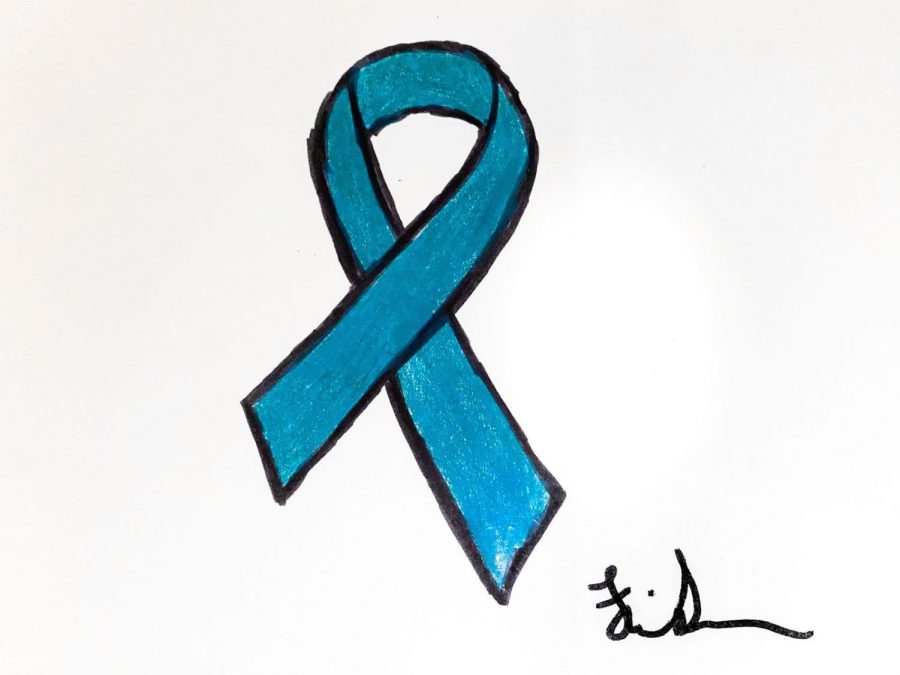Cervical Cancer Awareness Month recognizes survivors and victims of heartbreaking disease
Illustration of the teal and white cervical cancer awareness ribbon
When one thinks of January, they think of the first month of the year and the start of a new school semester. What some people don’t know is that January is also Cervical Cancer Awareness Month.
Cancer is a disease where the development of abnormal cells divide uncontrollably and have the ability to infiltrate and destroy normal body tissue. When cancer starts in the cervix (a cylinder-shaped neck of tissue that connects the vagina and uterus) it is called cervical cancer. Cervical cancer usually spreads slowly, but it can spread to the rest of the body without treatment.
According to Cancer.net, when detected at an early stage, the five-year survival rate for women with invasive cervical cancer is 92 percent. If cervical cancer has spread to surrounding tissues, organs and/or the regional lymph nodes, the five-year survival rate is 56 percent. If the cancer has spread to a distant part of the body, the five-year survival rate is 17 percent.
There are multiple ways to develop cervical cancer, including through human papillomavirus (HPV), sexually transmitted infections (STI), human immunodeficiency virus (HIV), and smoking.Only a small number of people with HPV develop cervical cancer. However, almost all cervical cancers contain the HPV virus. Still, there are different strains of HPV that are more likely to be precancerous.
“Cervical cancer is nearly always caused by infection with human papillomavirus (HPV), and cervical cancer screening is an essential part of a woman’s routine health care,” an employee of the National Cancer Institute said.
There are two tests to catch cervical cancer early, which are called the Pap Test and the HPV test. The Pap Test detects precancerous changes that can be treated before they lead to cancer. The HPV Test finds infections from high-risk HPV that are more likely to cause cervical cancer.
STIs are another cause of cervical cancer. Some risk factors for STIs are also risk factors of developing cervical cancer. They include having multiple male sexual partners, starting to have intercourse at a young age, and being diagnosed with other sexually transmitted diseases.
HIV is a risk for a different reason. HIV is a type of STI that hurts immune systems, which makes them more susceptible to cervical cancer.
Finally, smokers are twice as likely to develop cervical tumors. This is because people who smoke have a weaker immune system.
According to the Centers for Disease Control and Prevention, any woman can get cervical cancer, but it is most common in women above the age of 30. Cervical cancer is the fourth most common type of cancer, but because it is slow-spreading it is also one of the most preventable.
There are multiple treatments for cervical cancer, including surgery, radiation, and chemotherapy.
Using surgery, the doctors remove the cancer tissue in the earlier stages of cervical cancer to get rid of as much cancer as they can.
Radiation therapy uses high energy x-rays to kill cancer cells. It is used for both early and later stages of cervical cancer. Radiation therapy has shown to be a near equivalent treatment for early cervical cancer as surgery.
Chemotherapy is used after radiation therapy or surgery. While radiation therapy and surgery remove the cancer, there is sometimes a chance for it to come back. Chemotherapy is used to make sure that the cancer is permanently gone.
“The short answer is yes, I chose all of those things. The long answer is I didn’t know that I had a choice,” cancer survivor Christianna Valentina said when asked which of the above treatments she used.
There are a few ways to prevent cervical cancer. One way is to get a Pap Test, which is an annual test that can detect precancerous changes. There is also an HPV vaccine for people ages 12-26, which helps prevent HPV and the development of cervical cancer. These are not certain to prevent cervical cancer, but can help in most cases.
While there are more effective ways to detect cervical cancer, there are some symptoms. These include abnormal bleeding, abnormal vaginal discharge, pelvic or back pain, pain with urination, blood in the stool or urine, and pain during sex.
Cervical cancer is relatively common, which is why it is important to know the symptoms and protections against it. Cervical Cancer Awareness Month is an important time to recognize people with cervical cancer and to raise awareness of the subject.

Izzy is a sophomore, in her second year of journalism. She enjoys reading fantasy books, her family and eating anything with sugar. You can find her at...

Fiona Swan, is a junior at High School 1327 and this will be her first year in Advanced Journalism. She spends most of her free time surfing, discovering...







